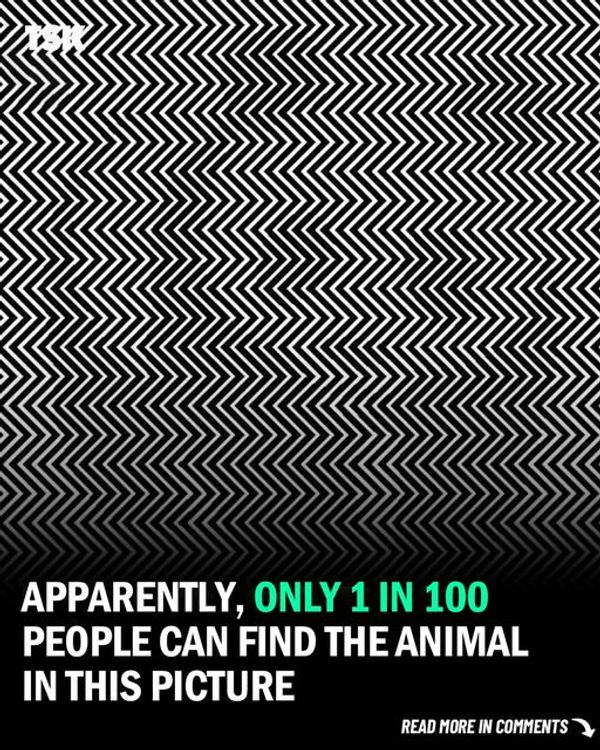Did you know that there’s an image that has recently gone viral because apparently, only 1% of people can find the animal in it? I wonder if you can do it!
Our brains are definitely hurting from trying to spot it, so we might have to come back to that one later. Ready for round two?

The McCollough Effect: A Strange Trick of the Mind
Let me introduce you to the McCollough effect. It’s this weird trick of the mind where, after staring at a colored grating (alternating lines), your brain starts to see a pinkish tinge or other colors when looking at black-and-white lines.
To trigger this effect, you simply need to stare at the center of two colored “induction images” for several minutes, switching back and forth repeatedly. It works best with green or red lines. Then, when you look at vertical black-and-white lines, you’ll find that they appear red, green, or pinkish in places.

How to Experience the McCollough Effect
Tilting your head 90 degrees may lessen or enhance the effect. In fact, rotating the induction images and staring at them again may actually reverse the effect. The longer you stare at the original induction images, the longer the effect will last – it can persist for hours, days, or even a few months in some cases.
Curious to know if it’s true and what’s causing this effect? Let’s dig deeper.

The Discoverer and Studies on the McCollough Effect
The effect is named after Celeste McCollough Howard, a US psychologist who was the first person to discover this “contingent aftereffect,” an illusion that affects your brain for an extended period of time.
Several studies have been conducted on the McCollough effect. In one study from 1975, two researchers tested five groups of 16 people and found that one group showed no lessening of the effect even after five days. The effect remained strong for four groups for up to 2,040 hours, which is almost three months!

You Can Test the Effect Yourself
Now, you might be wondering if you can experience this effect for yourself. Well, the answer is yes! Take a look at the images below. Note that there is a chance it can affect your vision for a while, but it only really gets triggered when you see vertical or horizontal lines afterwards. For the most part, it appears to be harmless. Up to you if you’d like to try it!
So, what’s causing this effect? There has been some debate about it. Three main lines of thought suggest that it has something to do with neurons in your visual cortex, your brain trying to color-correct the world and getting stuck, or a sort of withdrawal symptom, an absence of color.
Interesting Findings from a Study
In an interesting study from 1995, researchers examined a patient with significant brain damage who could only see color but little else. Surprisingly, the patient still reported the effect when shown black-and-white gratings after being exposed to red-and-green gratings (although he couldn’t notice the gratings). This led the researchers to conclude that the effect probably occurs within the visual cortex or somewhere between the eye and the brain.
How Prevalent is the McCollough Effect?
Various studies have looked into the prevalence of the McCollough effect. One study from 1969 found that stripes colored red and green produced the after-effects. Interestingly, if the induction image was green, then you’d see red colors on vertical grates and green colors on horizontal grates. If a red induction image was used, then the colors reversed.
It’s worth noting that only green and red seem to work for producing the effect. “Colors near pure blue and pure yellow, which had little red or green content, produced weak aftereffects,” the study noted. As far as we can tell, there isn’t a good explanation for why red and green are so good at producing the effect compared to others.
It’s All in the Brain
If you look at the image below, you should see red or green parts, or even pinkish. That’s the effect in action! It appears that the visual cortex in our brain is doing something, tricking our perception in one way or another. The exact mechanics behind it, though, are not completely understood. However, one thing is for sure – it’s a fascinating trick of the brain, and not a problem with our eyes themselves.
This serves as a good reminder that our brains are easily fooled. We struggle to tell parallel lines apart or get confused by concentric circles. Brains are indeed weird!





